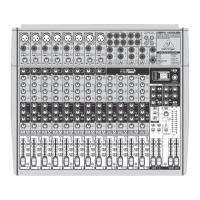
Do you have a question about the Xenyx X2442 USB and is the answer not in the manual?
| Brand | Xenyx |
|---|---|
| Model | X2442 USB |
| Category | Music Mixer |
| Language | English |
Lists essential operating instructions for safe use, including handling, ventilation, and cleaning.
Details precautions regarding plugs, grounding, and avoiding exposure to liquids or moisture.
Instructs users to refer servicing to qualified personnel and avoid unauthorized repairs.
Highlights the features of the high-end XENYX microphone preamps, including dynamic range and noise.
Describes the 3-band EQ based on classic British console circuitry for warm, musical sound.
Details the built-in 24-bit FX processor with 16 presets for reverb, delay, and modulation effects.
Explains the benefits of the switched-mode power supply (SMPS) for stable voltage and efficiency.
Introduces the FBQ system that uses LEDs to identify and eliminate feedback frequencies.
Describes the Voice Canceller filter for removing vocal parts, ideal for karaoke or practice.
Explains the three main functions of a mixing console: signal processing, level setting, and signal distribution.
Details the microphone and line inputs, and the GAIN control for mono channels.
Explains the 3-band equalizer and built-in compressor for mono channels.
Covers the monitor and effects busses (Aux Sends) for mono channels.
Explains the PAN, MUTE, SOLO, SUB, MAIN routing switches, and channel fader.
Explains the inputs, EQ, balance, and routing controls for stereo channels.
Details the stereo EQ section and balance control for stereo channels.
Explains how aux sends function for stereo channels, summing to mono.
Covers routing switches, SOLO, and channel fader for stereo channels.
Covers the main section controls including MON, AUX SENDs, SOLO, MUTE, and master faders.
Details the STEREO AUX RETURN jacks for effects mix return or additional line inputs.
Describes the separate monitor output, MON SEND fader, MUTE, and SOLO for the X1832USB.
Explains the STEREO AUX RETURN 1 control for main mix level and the special function of STEREO AUX RETURN 1/2 (TO AUX SEND).
Details how to set up an effects device for blending into a monitor mix using AUX SENDs and STEREO AUX RETURNs.
Explains the routing options for the FX/AUX 2 return fader on the X1832USB.
Describes the XPQ surround effect for widening stereo sound and its controls.
Provides more detail on the Voice Canceller filter and its application with CD/TAPE INPUTS.
Explains the RCA jacks for connecting 2-track recorders or other line-level sources.
Describes the BNC socket for connecting a gooseneck lamp.
Covers the control room and headphone outputs, level meters, and MODE switch for monitoring.
Explains how SUB switches route signals to subgroups, control room, and phones.
Details the control for adjusting the control room and headphone output levels.
Explains the PFL (Pre Fader Listen) and SOLO (Solo In Place) modes for signal monitoring.
Describes the high-precision faders for controlling subgroup and main mix output levels.
Explains how to activate the graphic equalizer and route it to main or monitor mixes.
Lists presets and explains how to use the Aux Send FX for input signal control.
Details controlling the effects level and selecting presets using the PROGRAM control.
Explains the FX OUT jack and the use of a footswitch to control the effects processor.
Details the balanced XLR and phone jack outputs for main mix and control room signals.
Describes the insert points for the main mix on the X2442USB model.
Explains the unbalanced subgroup outputs for routing channels to multiple destinations.
Details the function and use of insert points on mono input channels for signal processing.
Explains the direct post-EQ, post-mute, post-fader outputs for individual mono channels.
Details the USB connectivity for stereo audio transfer between the mixer and a computer.
Covers the IEC mains receptacle, power switch, and fuse replacement guidelines.
Explains the +48 V phantom power switch for condenser microphones and safety precautions.
Provides instructions for attaching the 19" rack mounts to the console for rack installation.
Illustrates wiring for various cables, including XLR, TS, and TRS connectors.
Explains how to connect RCA cables and unbalanced devices to balanced inputs/outputs.
Lists technical details for XENYX Mic Preamp inputs, including EIN, frequency response, and impedance.
Lists technical details for the 1/4" TRS line inputs, including impedance and gain range.
Provides crosstalk attenuation figures for main and channel faders when closed or muted.
Details the frequency response from microphone and stereo inputs to the main output.
Lists technical details for stereo inputs, including impedance and maximum input level.
Lists the frequency and gain ranges for the Low, Mid, and High EQ bands on mono channels.
Lists the frequency and gain ranges for the Low, Mid, and High EQ bands on stereo channels.
Lists technical details for Aux Sends and Stereo Aux Returns, including impedance and output levels.
Lists technical details for Main Outputs and Control Room Outputs, including impedance and maximum output levels.
Lists technical details for the headphones output, including connector type and maximum output level.
Lists technical details for the Digital Signal Processor (DSP) and USB interface, including converter and sample rates.
Provides the physical dimensions and net weight for each model of the mixer.
Lists noise figures for the main mix system under various fader conditions.